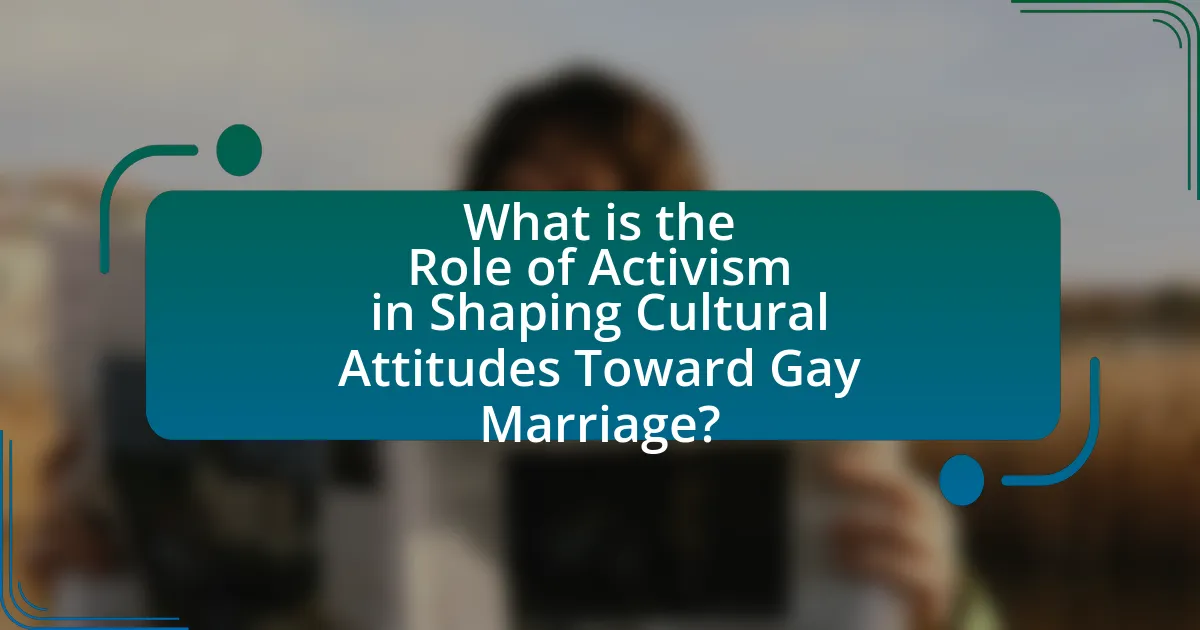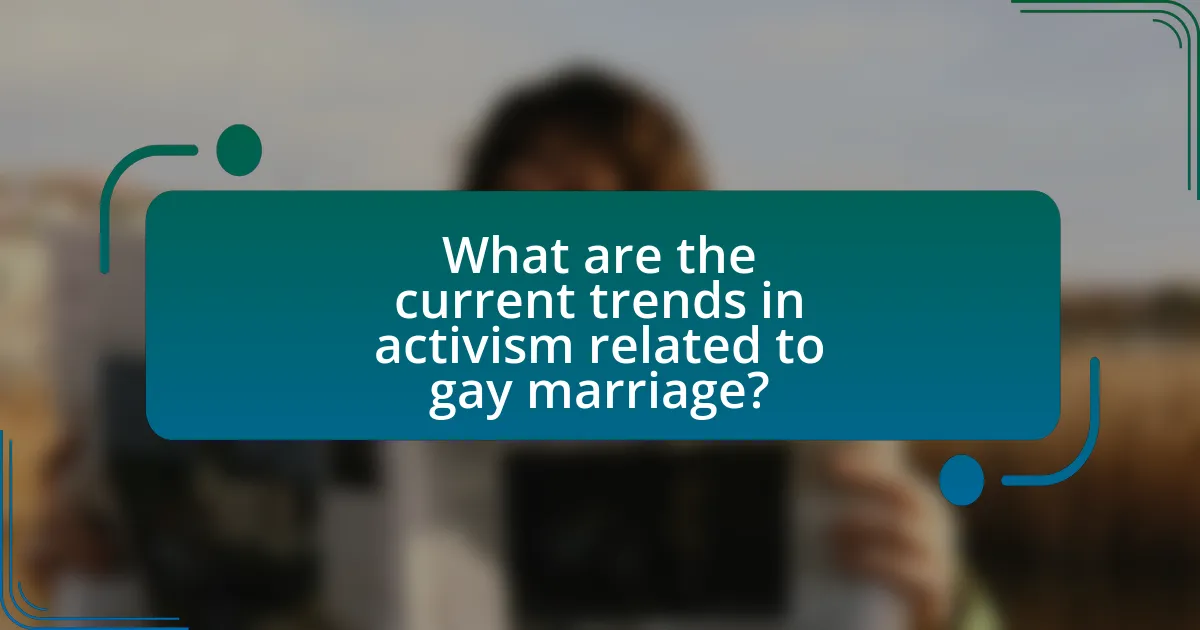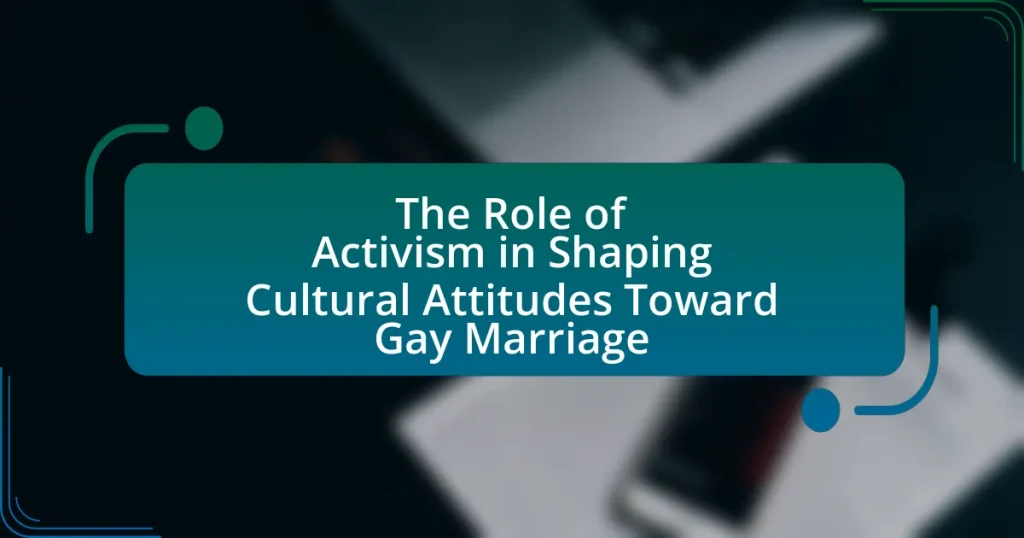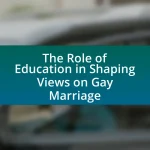The article examines the significant role of activism in shaping cultural attitudes toward gay marriage. It highlights how organized campaigns, protests, and educational initiatives have raised awareness and influenced public opinion, leading to increased support for same-sex marriage over the years. Key historical events, such as the Stonewall Riots and the Obergefell v. Hodges Supreme Court decision, are discussed as pivotal moments that reflect the impact of activism on legal recognition and societal acceptance. The article also explores the strategies employed by various activist groups, the challenges they face, and the importance of allyship in advancing the movement for marriage equality. Additionally, it addresses current trends and future directions for activism in the context of evolving cultural landscapes.

What is the Role of Activism in Shaping Cultural Attitudes Toward Gay Marriage?
Activism plays a crucial role in shaping cultural attitudes toward gay marriage by raising awareness, influencing public opinion, and advocating for legal changes. Through organized campaigns, protests, and educational initiatives, activists have successfully challenged societal norms and misconceptions about same-sex relationships. For instance, the Human Rights Campaign’s efforts in the United States significantly contributed to the shift in public support for gay marriage, which rose from 27% in 1996 to over 60% by 2019, according to a Gallup poll. This transformation in attitudes has been instrumental in the legalization of gay marriage in numerous states and countries, demonstrating that activism not only fosters dialogue but also drives legislative progress.
How has activism historically influenced perceptions of gay marriage?
Activism has historically influenced perceptions of gay marriage by challenging societal norms and advocating for legal recognition, which has shifted public opinion over time. For instance, the Stonewall Riots in 1969 marked a pivotal moment in LGBTQ+ activism, galvanizing efforts to fight for equal rights and visibility. This activism led to increased awareness and acceptance, culminating in significant milestones such as the legalization of same-sex marriage in various countries, including the U.S. Supreme Court’s decision in Obergefell v. Hodges in 2015, which recognized same-sex marriage as a constitutional right. Surveys indicate that public support for gay marriage has risen dramatically, from around 27% in 1996 to over 70% in recent years, reflecting the impact of sustained activism on societal attitudes.
What key events in activism have marked shifts in cultural attitudes?
Key events in activism that have marked shifts in cultural attitudes toward gay marriage include the Stonewall Riots of 1969, which catalyzed the modern LGBTQ+ rights movement, and the 2015 U.S. Supreme Court ruling in Obergefell v. Hodges, which legalized same-sex marriage nationwide. The Stonewall Riots sparked increased visibility and activism for LGBTQ+ rights, leading to annual Pride celebrations and advocacy for legal recognition. The Obergefell decision represented a significant legal victory, reflecting changing public opinion; a Gallup poll from 2015 indicated that 60% of Americans supported same-sex marriage, a dramatic increase from just 27% in 1996. These events collectively illustrate how activism has reshaped societal norms and legal frameworks regarding gay marriage.
How have different activist groups contributed to the gay marriage movement?
Different activist groups have significantly advanced the gay marriage movement by advocating for legal recognition and societal acceptance of same-sex unions. Organizations such as the Human Rights Campaign and GLAAD have mobilized public support through awareness campaigns, lobbying efforts, and legal challenges that have led to landmark court rulings, including the 2015 Supreme Court decision in Obergefell v. Hodges, which legalized same-sex marriage nationwide. Additionally, grassroots movements and local LGBTQ+ organizations have played crucial roles in fostering community support and visibility, thereby shifting cultural attitudes toward greater acceptance of gay marriage.
Why is activism important in the context of gay marriage?
Activism is crucial in the context of gay marriage because it drives social change and influences public opinion. Through organized efforts, activists raise awareness about the rights and dignity of LGBTQ+ individuals, challenging discriminatory practices and promoting equality. For instance, the 2015 Supreme Court decision in Obergefell v. Hodges, which legalized same-sex marriage nationwide, was significantly influenced by years of activism that highlighted the importance of marriage equality in achieving broader civil rights. This activism not only mobilized public support but also shifted cultural attitudes, making acceptance of gay marriage more prevalent in society.
What social changes have been driven by activism related to gay marriage?
Activism related to gay marriage has driven significant social changes, including increased acceptance of LGBTQ+ relationships and the legal recognition of same-sex marriage in many countries. This shift in societal attitudes is evidenced by the legalization of gay marriage in over 30 countries, including the United States in 2015, where the Supreme Court ruling in Obergefell v. Hodges affirmed the constitutional right to marry for same-sex couples. Additionally, public opinion polls indicate that support for gay marriage has risen dramatically, with a Gallup poll showing that support among Americans increased from 27% in 1996 to 70% in 2021. These changes reflect a broader cultural shift towards inclusivity and equality, driven by persistent advocacy and visibility efforts from LGBTQ+ activists.
How does activism challenge existing cultural norms regarding marriage?
Activism challenges existing cultural norms regarding marriage by advocating for the recognition and acceptance of diverse relationship structures, particularly same-sex marriage. This movement has reshaped public perceptions and legal frameworks, as seen in the U.S. Supreme Court’s 2015 decision in Obergefell v. Hodges, which legalized same-sex marriage nationwide. Activists have utilized various strategies, including public demonstrations, social media campaigns, and legal battles, to highlight the inequalities faced by LGBTQ+ individuals and to promote the idea that love and commitment should not be restricted by gender. These efforts have led to significant shifts in societal attitudes, with increasing support for marriage equality reflected in polls, such as a Gallup survey in 2021 showing that 70% of Americans favored same-sex marriage, up from just 27% in 1996.
What strategies do activists use to promote gay marriage acceptance?
Activists promote gay marriage acceptance through various strategies, including public education campaigns, legal advocacy, and grassroots organizing. Public education campaigns aim to raise awareness and foster understanding by sharing personal stories and data that highlight the benefits of marriage equality, such as improved mental health outcomes for LGBTQ+ individuals. Legal advocacy involves challenging discriminatory laws and policies in courts, exemplified by landmark cases like Obergefell v. Hodges, which legalized same-sex marriage in the United States. Grassroots organizing mobilizes community support and encourages individuals to participate in demonstrations, rallies, and lobbying efforts, effectively amplifying the voices of LGBTQ+ individuals and their allies. These strategies collectively contribute to shifting cultural attitudes and increasing acceptance of gay marriage.
How do social media campaigns impact public opinion on gay marriage?
Social media campaigns significantly influence public opinion on gay marriage by facilitating widespread dialogue and increasing visibility of LGBTQ+ issues. These campaigns often utilize hashtags, viral content, and personal stories to engage users, creating a sense of community and shared experience. Research indicates that exposure to pro-gay marriage content on platforms like Facebook and Twitter correlates with increased support for marriage equality; for example, a study published in the journal “Science” found that individuals who were exposed to supportive messages from friends were more likely to change their views positively. Additionally, social media campaigns can mobilize grassroots activism, leading to real-world actions such as protests and petitions, further shaping societal attitudes toward gay marriage.
What role do public demonstrations play in shaping cultural attitudes?
Public demonstrations play a crucial role in shaping cultural attitudes by providing a visible platform for collective expression and advocacy. These events mobilize communities, raise awareness about specific issues, and challenge prevailing norms, thereby influencing public perception. For instance, the Stonewall Riots in 1969 catalyzed the LGBTQ+ rights movement, leading to significant shifts in societal attitudes toward gay marriage over the following decades. Research indicates that sustained visibility through demonstrations correlates with increased acceptance; a 2019 study published in the Journal of Social Issues found that communities exposed to LGBTQ+ pride events reported higher levels of support for same-sex marriage. Thus, public demonstrations serve as a powerful mechanism for cultural change by fostering dialogue and promoting inclusivity.
How does activism intersect with legal changes regarding gay marriage?
Activism plays a crucial role in driving legal changes regarding gay marriage by mobilizing public support and influencing policymakers. For instance, grassroots campaigns and advocacy organizations, such as the Human Rights Campaign, have effectively raised awareness about LGBTQ+ rights, leading to significant legal milestones like the U.S. Supreme Court’s decision in Obergefell v. Hodges in 2015, which legalized same-sex marriage nationwide. This intersection of activism and legal reform demonstrates how sustained efforts to challenge societal norms can result in transformative legal outcomes, reflecting changing cultural attitudes toward gay marriage.
What challenges do activists face in promoting gay marriage?
Activists face significant challenges in promoting gay marriage, primarily stemming from societal opposition, legal barriers, and political resistance. Societal opposition includes deeply ingrained cultural and religious beliefs that view same-sex marriage unfavorably, which can lead to public protests and negative media portrayals. Legal barriers often manifest in the form of restrictive laws or constitutional amendments that explicitly prohibit same-sex marriage, complicating activists’ efforts to achieve legal recognition. Political resistance is evident when lawmakers refuse to support or advance legislation that would legalize gay marriage, often influenced by their constituents’ views or party affiliations. For instance, in the United States, the Defense of Marriage Act (DOMA) enacted in 1996 defined marriage as a union between one man and one woman, illustrating the legal obstacles activists had to overcome. These challenges collectively hinder the progress of gay marriage advocacy and require sustained efforts from activists to shift public perception and influence policy change.

What are the current trends in activism related to gay marriage?
Current trends in activism related to gay marriage include a focus on intersectionality, digital mobilization, and legislative advocacy. Activists are increasingly addressing the unique challenges faced by LGBTQ+ individuals of diverse backgrounds, emphasizing the need for inclusive policies that consider race, gender identity, and socioeconomic status. Digital platforms are being utilized to organize campaigns, raise awareness, and mobilize support, allowing for broader outreach and engagement. Additionally, there is a concerted effort to influence legislation at local, state, and national levels, with activists pushing for protections against discrimination and advocating for marriage equality in regions where it remains contested. These trends reflect a dynamic and evolving landscape of activism aimed at advancing gay marriage rights and fostering cultural acceptance.
How are new generations of activists approaching the gay marriage issue?
New generations of activists are approaching the gay marriage issue by leveraging digital platforms and intersectional advocacy to promote inclusivity and equality. These activists utilize social media to mobilize support, share personal stories, and raise awareness about the ongoing challenges faced by LGBTQ+ individuals, emphasizing that marriage equality is part of a broader fight for human rights. For instance, campaigns like #LoveIsLove have gained significant traction online, illustrating the power of grassroots movements in shaping public opinion and policy. Additionally, younger activists often collaborate with diverse groups, recognizing that issues such as race, gender identity, and socioeconomic status intersect with the fight for marriage equality, thereby fostering a more comprehensive approach to advocacy.
What innovative methods are being used to engage the public?
Innovative methods used to engage the public include social media campaigns, interactive events, and storytelling initiatives. Social media campaigns leverage platforms like Instagram and Twitter to spread awareness and foster community discussions, evidenced by the success of hashtags like #LoveIsLove, which mobilized millions during Pride Month. Interactive events, such as workshops and community forums, encourage direct participation and dialogue, enhancing understanding and empathy. Storytelling initiatives, including personal narratives shared through blogs and videos, humanize the issues surrounding gay marriage, making them relatable and impactful. These methods collectively create a dynamic environment for public engagement and awareness.
How do intersectional issues affect the gay marriage activism landscape?
Intersectional issues significantly affect the gay marriage activism landscape by highlighting the diverse experiences and challenges faced by individuals within the LGBTQ+ community. Activists must address how factors such as race, gender identity, socioeconomic status, and disability intersect with sexual orientation, influencing access to rights and representation. For instance, studies show that Black and Latino LGBTQ+ individuals often encounter compounded discrimination, which can lead to differing priorities in activism compared to their white counterparts. This complexity necessitates a more inclusive approach to advocacy, ensuring that the voices of marginalized groups are heard and considered in the fight for marriage equality.
What role do allies play in the activism for gay marriage?
Allies play a crucial role in the activism for gay marriage by amplifying the voices of the LGBTQ+ community and providing essential support in advocacy efforts. Their involvement helps to challenge societal norms and prejudices, fostering a more inclusive environment. For instance, allies often participate in protests, engage in conversations to educate others, and use their platforms to raise awareness about the importance of marriage equality. Research indicates that public support from allies significantly influences legislative outcomes; a study by the Williams Institute found that increased visibility of allies correlates with higher public approval ratings for same-sex marriage. This demonstrates that allies not only contribute to activism but also help shift cultural attitudes toward acceptance and equality.
How can allies effectively support gay marriage activism?
Allies can effectively support gay marriage activism by actively participating in advocacy efforts, such as attending rallies, signing petitions, and engaging in conversations that promote equality. Their involvement amplifies the voices of the LGBTQ+ community and demonstrates solidarity. For instance, studies show that public demonstrations can significantly influence public opinion; a 2019 survey indicated that 70% of Americans support same-sex marriage, partly due to increased visibility and advocacy efforts. By leveraging their privilege, allies can challenge discriminatory practices and policies, thereby fostering a more inclusive society.
What impact do allyship and solidarity have on cultural attitudes?
Allyship and solidarity significantly influence cultural attitudes by fostering inclusivity and challenging discriminatory norms. When individuals and groups actively support marginalized communities, they create a collective identity that promotes acceptance and understanding. Research indicates that public displays of allyship, such as participation in pride events or advocacy campaigns, can lead to increased societal acceptance of LGBTQ+ individuals, as evidenced by a 2019 study published in the Journal of Social Issues, which found that communities with visible allyship initiatives reported higher levels of support for gay marriage. This demonstrates that allyship and solidarity not only enhance the visibility of marginalized voices but also contribute to shifting cultural perceptions toward greater equality and acceptance.

What future directions can activism take in shaping attitudes toward gay marriage?
Activism can take future directions by focusing on education, representation, and intersectionality to shape attitudes toward gay marriage. Educational campaigns that highlight the benefits of marriage equality and personal stories can foster empathy and understanding among diverse audiences. Increased representation of LGBTQ+ individuals in media and politics can normalize gay marriage and challenge stereotypes. Additionally, addressing intersectional issues, such as race and socioeconomic status, can broaden the movement’s appeal and inclusivity, thereby enhancing its effectiveness. Research indicates that states with active LGBTQ+ advocacy groups have seen more favorable public attitudes toward gay marriage, demonstrating the impact of organized activism on societal perceptions.
How can activism adapt to changing cultural landscapes?
Activism can adapt to changing cultural landscapes by leveraging digital platforms and grassroots movements to engage diverse communities. As cultural attitudes evolve, particularly regarding issues like gay marriage, activists can utilize social media to amplify their messages and connect with younger, more progressive audiences. For instance, the rapid acceptance of gay marriage in various countries can be attributed to effective online campaigns that mobilized public support and influenced legislative changes. Research by the Williams Institute indicates that public support for same-sex marriage increased from 27% in 1996 to 70% in 2021, showcasing how activism can shift cultural perceptions through strategic communication and community involvement.
What emerging issues might activists need to address in the future?
Activists may need to address the increasing challenges related to LGBTQ+ rights in the context of global political shifts. As countries experience rising nationalism and conservatism, there is a potential rollback of previously gained rights, as seen in nations like Hungary and Poland, where anti-LGBTQ+ legislation has been enacted. Additionally, activists must confront the intersectionality of issues such as racial justice, economic inequality, and healthcare access, which disproportionately affect LGBTQ+ individuals, particularly those from marginalized communities. The ongoing impact of technology on privacy and surveillance also presents new challenges, as activists must navigate the implications of digital rights and data protection for LGBTQ+ individuals.
How can activists leverage technology for future campaigns?
Activists can leverage technology for future campaigns by utilizing social media platforms to amplify their messages and engage with a broader audience. Social media allows activists to share information quickly, mobilize supporters, and create viral content that raises awareness about issues related to gay marriage. For instance, campaigns like the Human Rights Campaign’s “Love Conquers Hate” effectively used platforms like Facebook and Twitter to reach millions, influencing public opinion and policy changes. Additionally, data analytics tools can help activists understand audience demographics and tailor their strategies for maximum impact, as evidenced by the targeted advertising used in successful campaigns during the legalization of gay marriage in various states.
What practical steps can individuals take to support gay marriage activism?
Individuals can support gay marriage activism by participating in advocacy campaigns, donating to LGBTQ+ organizations, and educating themselves and others about LGBTQ+ rights. Engaging in advocacy campaigns, such as signing petitions or attending rallies, directly influences public opinion and policy changes. Donating to organizations like the Human Rights Campaign or GLAAD provides essential resources for legal battles and awareness initiatives. Furthermore, educating oneself and others fosters understanding and acceptance, which is crucial for shifting cultural attitudes; studies show that increased awareness correlates with greater support for LGBTQ+ rights.


